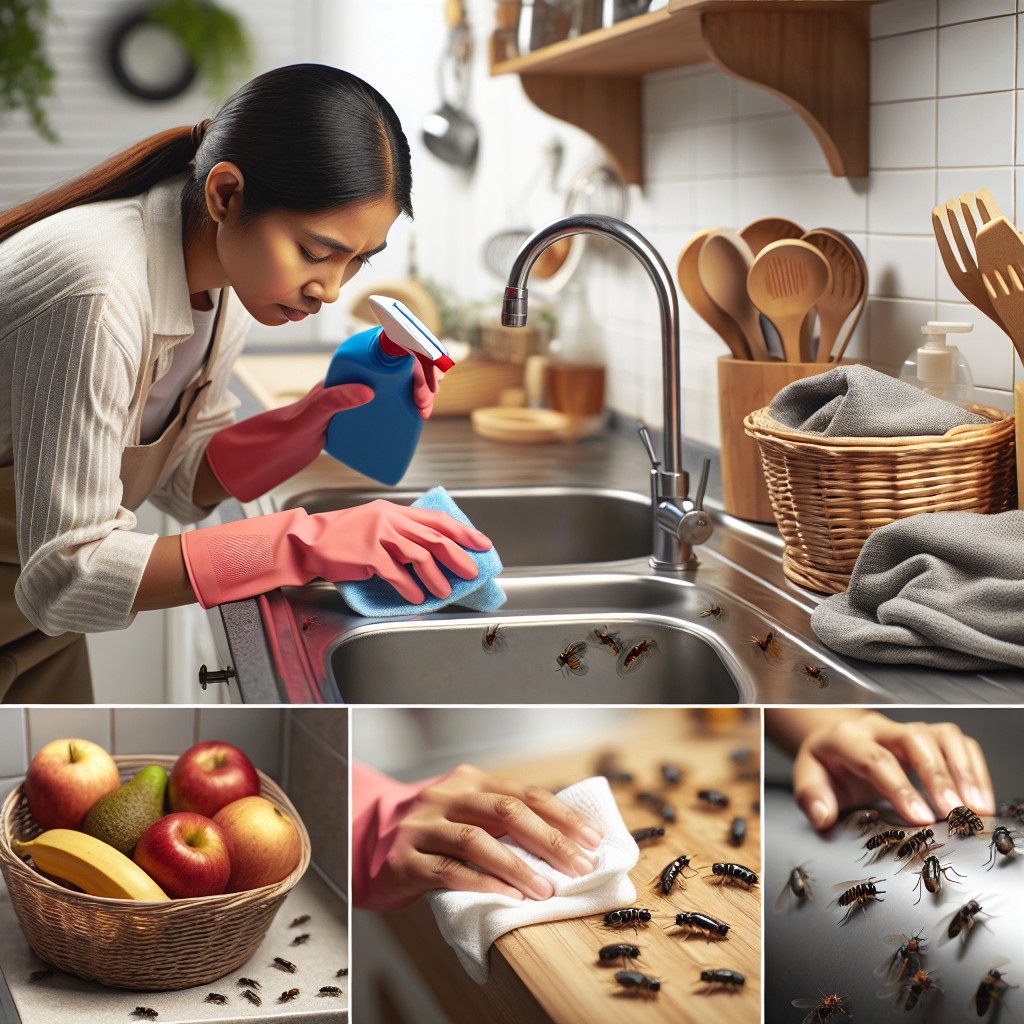Last updated on
In this practical guide, you’ll discover effective methods for eliminating fruit flies from your home with an emphasis on prevention strategies.
Key takeaways:
- Wipe down surfaces that attract fruit flies.
- Set traps using vinegar, beer, ripe fruit, sticky traps, or electric traps.
- Regularly maintain your home to keep fruit flies away.
- Seal gaps and secure your home against fruit fly invasion.
- Understand the causes of fruit fly infestations.
What's Inside
Wipe Down Surfaces That Are Potential Breeding Grounds

Ensuring your kitchen and dining areas are free of food residues and spills is a critical step in combating fruit fly populations. Without lingering sugars and organic materials, these pests lack the resources they need to thrive.
Here’s how to effectively clean surfaces:
- Use a solution of warm water and dish soap to scrub countertops, tables, and stove tops after each use. The soap cuts through the grime that attracts fruit flies.
- Don’t overlook the less obvious spots, such as the sides of appliances and underneath cutting boards—fruit flies will find these hidden sugars.
- For tougher areas, consider a mixture of water and vinegar. The acidity helps dissolve sticky residues and can deter flies with its scent.
- Immediately soak or rinse used dishes, as even a trace of juice or wine can serve as a fruit fly magnet.
- Regularly clean and disinfect trash bins and recycling containers, where fruit flies often breed. To ensure effectiveness, do this task outside your living space to prevent flies from simply relocating.
By maintaining spotless surfaces, you obstruct a critical part of the fruit fly life cycle, making your home much less enticing for these unwelcome visitors.
Set Traps
Trapping fruit flies is a highly effective method of reducing their numbers quickly. Use a variety of homemade or store-bought options:
1. Vinegar and dish soap trap: Fill a bowl with apple cider vinegar, cover it with plastic wrap, and poke small holes in the top. The scent lures them in, and the dish soap added to the vinegar breaks the surface tension, causing flies to sink.
2. Beer or wine trap: Similar to the vinegar trap, an open container with a bit of beer or wine can attract fruit flies with their fermented scent. Place a funnel on top to guide them into the container from which they cannot escape.
3. Ripe fruit in a jar: Put overly ripe or rotting fruit at the bottom of a jar, cover the mouth with plastic wrap, and poke holes. Flies enter but find it difficult to leave, attracted by the natural fruit scent.
4. Sticky trap: Hang a commercially-available sticky fly trap near infestation areas. As fruit flies are drawn to light and movement, they will stick to the adhesive.
5. Electric traps: These plug-in devices use UV light to attract fruit flies and then catch or zap them upon contact.
Regularly check and clean out these traps to continue effectively managing the fruit fly population. Remember, persistence is key with these tenacious little pests.
Regular Maintenance to Help Keep Fruit Flies Away
Maintaining a fruit fly-free environment requires consistency. Here’s how to ensure your home stays unappealing to these persistent pests.
1. Compost Wisdom: Dispose of kitchen scraps and overripe fruits promptly. If you compost, ensure it’s well-covered and located far from your home.
2. Tight Seals on Trash: Secure trash can lids, and regularly clean containers to eliminate any residue that could attract fruit flies.
3. Clean Drains: Fruit flies love to breed in the sludge that builds up in drains. Use a drain cleaner or a natural mix of baking soda and vinegar followed by boiling water to keep drains clear.
4. Dry and De-clutter: Minimize clutter and wipe up spills immediately, especially sweet or fermented liquids which are fruit fly favorites.
5. Fruit Storage: Refrigerate ripe fruit and check stored produce regularly for signs of over-ripening or decay—both hotbeds for fruit fly breeding.
By integrating these habits into your routine, you create an environment that is far less inviting to fruit flies, effectively keeping them at bay.
Seal the Gaps
Keeping fruit flies out involves more than just cleanliness; it’s about securing your home against invasion. Think of it as fortifying your space.
Start by checking for and repairing any window screen tears—they’re an open invitation to these pests. Inspect doors for gaps, and consider a door sweep to block entry underneath.
Next, place your attention on the smaller entry points. Seal around pipes and vents with caulk, and address any cracks in your walls or foundation.
Your drainage system warrants a look—ensure that all sink, bathroom, and floor drains are in good shape and cover them with fine mesh when not in use to prevent fruit flies from emerging.
These steps do more than combat fruit flies; they boost overall home pest prevention, creating a barrier against various unwanted guests.
Now, having sealed the gaps, maintain vigilance. Regular checks for new or missed openings reinforce your defenses and keep your home fly-free.
What Causes Fruit Fly Infestations Indoors?
Fruit flies are attracted to fermenting fruits and vegetables, seeking out the yeast produced during the decomposition process. These tiny insects have an incredible sense of smell and can detect the presence of ripe produce from a great distance.
Excess moisture is another draw for fruit flies. Areas where water collects, such as a sink with dirty dishes or a mop bucket, provide perfect breeding conditions.
Trash receptacles with decaying food remnants are virtual invitations for infestation. A garbage can with a lingering banana peel or an old, forgotten potato at the bottom is akin to a fruit fly hotel with a ‘Vacancy’ sign lit up.
Fruit flies may also come from the outside when you bring in garden produce. These could be the ‘Trojan horses’ carrying fruit fly larvae, ready to hatch and multiply once inside your home.
Recycling bins with containers that once held sweet liquids, like soda or juice, can also foster fruit fly populations if not rinsed out properly.
Lastly, grocery stores are an inadvertent source of fruit flies. A single piece of fruit purchased from the store can harbor fruit fly eggs or larvae, unknowingly introducing them into your home environment.




